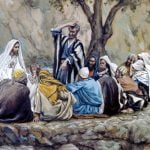
Hermeneutics and Figurative Language – Part One
I recently wrote some articles on biblical interpretation, examining various general principles that we must keep in mind as we seek to rightly handle the Word of God. I mentioned that future articles would look at special principles. So here I will begin to do this.
Various figures of speech will be considered here. This piece was prompted by a comment I recently received to my website. It had to do with my earlier article on tattoos. The person said he was not a fan of tattoos, but he was curious about Revelation 19:12 and 16, which say:
 “He has a name written on him that no one knows but he himself”
“He has a name written on him that no one knows but he himself”
“On his robe and on his thigh he has this name written: ‘KING OF KINGS AND LORD OF LORDS’.”
This is how I replied to him:
Thanks ****. The book of Revelation is full of symbolism and figurative language, such as metaphor. That is a characteristic of apocalyptic writings, also found in places like Isaiah 24-27; Daniel 7–12; and Zechariah 1–8. As I have written elsewhere, ‘It is highly symbolic with striking imagery and style. The highly symbolic and esoteric nature of these writings makes it difficult to interpret.’
https://billmuehlenberg.com/2018/12/26/bible-study-helps-revelation/So just as we would not take metaphors literally as we find them in the gospels, for example, Jesus calling himself the door (John 10:9), so too we should not take them literally here. Many of these passages make use of metaphors. Indeed, simply read the first part of verse 12: “His eyes are like blazing fire, and on his head are many crowns”. If these are actual, literal features of Christ, at the very least, they are somewhat strange. He would need a rather large head to hold all those crowns for example. So most folks simply recognise that metaphorical language is being used here.
The same with other descriptions of Christ in Revelation. In 19:15 we read this: “Coming out of his mouth is a sharp sword with which to strike down the nations.” Once again, we have a clear use of figurative language – in this case, metaphor.
In the same way we read about God inscribing us on the palm of his hands (Isaiah 49:16). But as I mentioned above, this too is of course metaphorical language, since God has no hands – he is a spirit, and not a physical being!
And even if we do want to take the two verses you mention much more literally, it is possible that the name of v. 12 is written on his diadem. And we read that his robe has a name on it in v. 16, so maybe that includes the name on his thigh.
But to wrap this up: however we understand some of these amazing and mysterious pictures of Christ and God in Revelation – and elsewhere – they often involve at least some use of metaphor and figurative language. As such, they really are not directly related to our current debate over tattoos.
Let me spend the rest of this article looking at this issue of figurative language in more detail. Let me begin by asking a question that many believers have: ‘Should we read the Bible literally?’ The short answer is ‘yes and no.’ But that issue I have dealt with before, so I invite you to read this article: https://billmuehlenberg.com/2010/12/02/should-we-read-the-bible-literally/
Figures of speech
Simply put, the Bible is full of figures of speech. Jesus used them quite often for example. In 1898 E. W. Bullinger wrote a book called Figures of Speech Used in the Bible. In it he classified over 200 types of figures of speech. You will be pleased to know that I will not deal with all of them here.
Let me point out that any good book on hermeneutics will deal with all this carefully, and provide helpful definitions and examples of each of the main figures of speech. I put a bibliography together on this back in 2011: https://billmuehlenberg.com/2011/01/19/recommended-reading-on-hermeneutics/
One excellent and very thorough volume that I would add to the list is this:
Ryken, Leland, James Wilhoit and Tremper Longman, eds., Dictionary of Biblical Imagery. InterVarsity Press, 1998.
But let me look at some of these major figures of speech. I have already looked at metaphors, but a bit more can be said. According to one online dictionary a metaphor is
an expression, often found in literature, that describes a person or object by referring to something that is considered to have similar characteristics to that person or object:
“The mind is an ocean” and “the city is a jungle” are both metaphors.
Metaphor and simile are the most commonly used figures of speech in everyday language.
Thus a writer describes one thing in terms of something else. Biblical examples include:
Psalm 23:1 The LORD is my shepherd, I shall not be in want.
Jeremiah 2:13 My people have committed two sins: They have forsaken me, the spring of living water, and have dug their own cisterns, broken cisterns that cannot hold water.
Luke 12:32 Do not be afraid, little flock, for your Father has been pleased to give you the kingdom.
John 1:29 The next day John saw Jesus coming toward him and said, “Look, the Lamb of God, who takes away the sin of the world!
John 10:9 I am the gate; whoever enters through me will be saved. He will come in and go out, and find pasture.
Quite similar are allegories. They are extended metaphors. They are stories making a comparison. They use fictional or symbolic means to express various truths. One very famous non-biblical example of this of course is The Pilgrim’s Progress by John Bunyan. The story and meaning are intertwined in an allegory. Some examples are found here:
Galatians 4:21-31 – Hagar and Sarah
John 10:1-16 – the door and the good shepherd
Song of Solomon 4:11-13 – human love and God’s love
A simile makes comparisons, using words such as ‘like’ or ‘as’. Here are some examples:
Psalm 42:1 As the deer pants for streams of water, so my soul pants for you, O God.
Isaiah 53:6,7 We all, like sheep, have gone astray, each of us has turned to his own way; and the LORD has laid on him the iniquity of us all. He was oppressed and afflicted, yet he did not open his mouth; he was led like a lamb to the slaughter, and as a sheep before her shearers is silent, so he did not open his mouth.
Luke 10:3 Go! I am sending you out like lambs among wolves.
Matthew 13:31 He told them another parable: “The kingdom of heaven is like a mustard seed, which a man took and planted in his field.”
Matthew 23:37 O Jerusalem, Jerusalem, you who kill the prophets and stone those sent to you, how often I have longed to gather your children together, as a hen gathers her chicks under her wings, but you were not willing.
Related to this are parables. A parable is an extended simile. These are short, fictional stories making a point, or teaching a lesson, by means of comparison. They often involve stories or depictions of earthly life which both illustrate spiritual truths and call for a response.
Perhaps as much as a third of Jesus’ teaching in the Synoptic Gospels comes in the form of parables. They are used by Jesus to teach spiritual truths and are two-edged swords: those who are open to the truth will get the meaning, but those who are closed to truth (‘eyes that do not see, ears that do not hear’) will miss out. Some passages speaking to this include:
John 10:19 At these words the Jews were again divided.
Matthew 13:10-15 The disciples came to him and asked, “Why do you speak to the people in parables?” He replied, “The knowledge of the secrets of the kingdom of heaven has been given to you, but not to them. Whoever has will be given more, and he will have an abundance. Whoever does not have, even what he has will be taken from him. This is why I speak to them in parables: “Though seeing, they do not see; though hearing, they do not hear or understand. In them is fulfilled the prophecy of Isaiah: “‘You will be ever hearing but never understanding; you will be ever seeing but never perceiving. For this people’s heart has become calloused; they hardly hear with their ears, and they have closed their eyes. Otherwise they might see with their eyes, hear with their ears, understand with their hearts and turn, and I would heal them.’
Mark 4:11-12 He told them, “The secret of the kingdom of God has been given to you. But to those on the outside everything is said in parables so that, “‘they may be ever seeing but never perceiving, and ever hearing but never understanding; otherwise they might turn and be forgiven!'”
Well-known parables include the parable of the tares and the wheat (Matthew 13:24-30), and the parable of the soils (Matthew 13:1-9). One thing to keep in mind is to look for the main point trying to be expressed, and don’t press the details. For example, in the parable of the unjust steward (Luke 16:1-9) the dishonesty of the steward is not being commended, but his resolution and astuteness.
And sometimes a generalising conclusion closes off a parable:
Matthew 20:16 “So the last will be first, and the first will be last” (the parable of the workers).
Matthew 25:13 “Therefore keep watch, because you do not know the day or the hour” (the parable of the ten virgins).
Matthew 25:29 “For everyone who has will be given more, and he will have an abundance. Whoever does not have, even what he has will be taken from him” (the parable of the talents).
A metonymy involves words of association – words that are used in place of another. We do this all the time in our speech. For example, we hear on the news, ‘Washington said today’ which means that the President said something, or this is official US policy, etc.
Being aware of this can help us deal with what can be confusing at times in the Old Testament. For example, Ephraim can stand for all of the Northern Kingdom, even though it is only one of 10 tribes there. And Judah often stands for the Southern Kingdom, even though it is only one of several tribes.
Other examples can be less unclear. In the New Testament for example the ‘circumcision’ often refers to the Jews. And the ‘uncircumcised’ will refer to gentiles – see Galatians 2:7-9 for a case of this. And Romans 3:30 as well: “since there is only one God, who will justify the circumcised by faith and the uncircumcised through that same faith.”
Other examples include:
Genesis 42:38 But Jacob said, “My son will not go down there with you; his brother is dead and he is the only one left. If harm comes to him on the journey you are taking, you will bring my gray head down to the grave in sorrow.” (This of course refers to an old man who will go to the grave in sorrow if he loses his son.)
Luke 16:29 Abraham replied, ‘They have Moses and the Prophets; let them listen to them.’ (That is shorthand for the writings of Moses and the prophets.)
Two more examples that should need no explanation:
Proverbs 12:19 Truthful lips endure forever, but a lying tongue lasts only a moment.
James 3:6 The tongue also is a fire, a world of evil among the parts of the body. It corrupts the whole person, sets the whole course of his life on fire, and is itself set on fire by hell.
There are many other figures of speech worth looking at, so head to Part Two of this article for more: https://billmuehlenberg.com/2019/07/20/hermeneutics-and-figurative-language-part-two/
[1984 words]




















Yes Bill, as you write in your article,” should we take the bible literally, ” the answer is “yes and no”. When Jesus said that ” He was the Bread of Life” John 6: 35, He wasn’t saying that He was a loaf of bread, He was pointing to Himself, that He is our Spiritual Food and also to feed on His Word, its His Word that brings life.
And in John 15.5 Jesus said, “I am the vine;” He wasn’t saying that He was a plant.
In John 6.54. When Jesus says “Whoever eats my flesh and drinks my blood has eternal life……..
He wasn’t saying to eat his flesh literally, He explains what He means in John 6. 63. 63. The Spirit gives life; (eternal life) the flesh counts for nothing. The WORDS I Have spoken to you – they are full of the Spirit and Life. We are to feed/ meditate, read study His WORDS for our spiritual life.
There are many Scriptures similar. Also Matthew 4.4…….Man shall not live by bread alone, but by every word that proceeds out of the mouth of God. This scripture verse has been a blessing to me, reminding me to feed ( read study meditate) on the word of God for my spiritual wellbeing and life eternal, the Life Of Christ feeding my soul.
Thanks, Bill. These literary terms are often skipped over because – well – they are too literary!
Appreciate the review.
Bill…I just learned a new word, “metonymy”. I understood the principle before I knew the word and I really appreciate this review of the basics too.